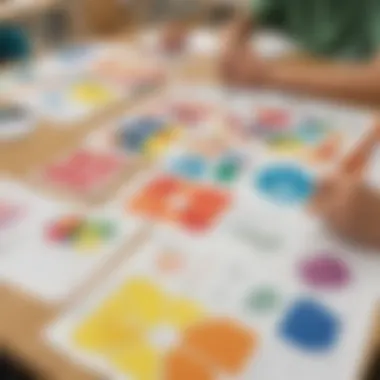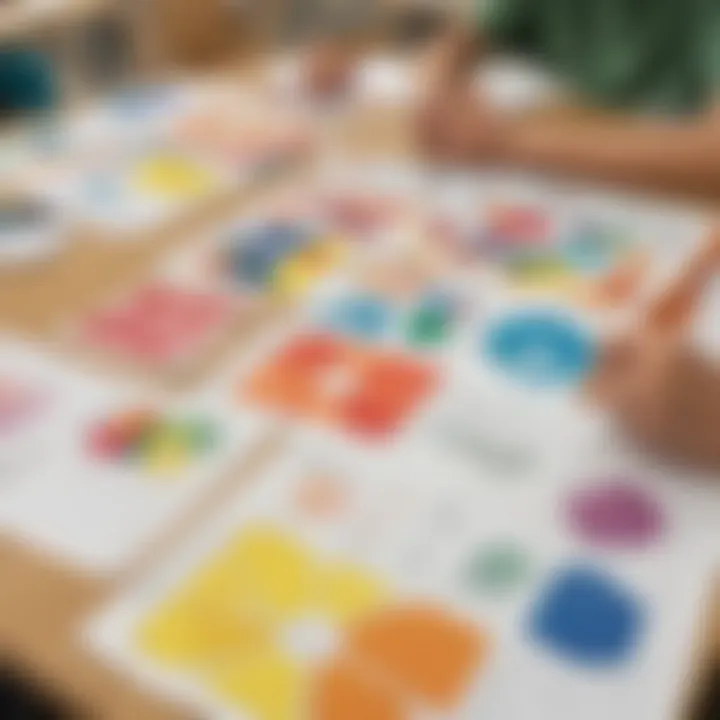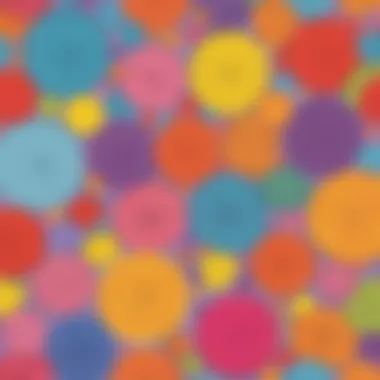Exploring the Colour by Shape Worksheet for Kids


Intro
Colour by Shape worksheets serve as essential educational tools. They provide a simple way for children to explore and learn about colors and shapes. Through engaging activities, these worksheets foster cognitive development in young learners. Understanding the significance of combining colors and shapes helps in enhancing their spatial awareness and creativity.
Key highlights of this article include:
- The educational advantages of Colour by Shape worksheets.
- Effective methods for implementing these resources in the classroom and at home.
- Creative activities and their relevance in supporting a child’s learning journey.
With this in mind, we will explore in detail the various aspects of Colour by Shape worksheets, leading to more effective educational strategies that both educators and parents can utilize.
Preface to Colour by Shape Worksheets
Color by shape worksheets play a vital role in early childhood education. These worksheets serve as a bridge for children to learn about colors, shapes, and their relationships. The concept behind these worksheets is simple yet profound. They encourage learners to identify shapes and match them with their corresponding colors. This interaction is critical as it enhances cognitive development at a young age, fostering skills that are essential for future learning.
One of the main benefits of color by shape worksheets is their ability to seamlessly integrate visual learning with practical application. Organizing colors and shapes helps children develop their classification skills. It also promotes an understanding of spatial awareness and encourages fine motor skills through activities like coloring and tracing.
Furthermore, engaging with these worksheets allows children to experience immediate feedback, something that is crucial for their learning process. When a child colors a shape correctly, they receive affirmation, which boosts their confidence. This simple yet effective teaching tool is adaptable, making it suitable for various learning styles and paces.
"Effective learning tools should cater to the diverse needs of children, fostering development in a supportive manner."
It's important for educators and parents to recognize how these worksheets can be used not just as a fun activity, but also as a serious educational strategy. The implementation of color by shape worksheets can lead to significant strides in a child's understanding of their environment, as they learn to classify and identify both colors and shapes in the world around them.
Cognitive Benefits of Colour and Shape Recognition
Understanding colours and shapes is foundational in a child’s cognitive development. These elements not only enhance visual discernment but also contribute significantly to problem-solving capabilities and critical thinking skills. Children who engage with Colour by Shape worksheets are likely to experience a variety of cognitive benefits, improving their ability to comprehend their environment.
Visual Processing Skills
Visual processing refers to the brain's ability to interpret and make sense of what the eyes see. Children who actively work with Colour by Shape worksheets can significantly improve their visual processing skills. This improvement occurs through a series of interactive tasks that promote attention to detail. As children sort, match, and identify different colours and shapes, they sharpen their ability to distinguish differences and similarities.
One effective method to enhance visual processing is through activities that require children to focus on specific characteristics of shapes and colours. For instance, asking them to find all blue triangles within a set of shapes can help them develop quick recognition abilities. Such activities can lead to improved memory recall and heightened attention spans.
Incorporating stickers, stamps, or even digital applications can make these activities more engaging. When children associate learning with fun tools, their motivation to participate increases, fostering better development of visual processing skills.
Critical Thinking Development
Engaging with Colour by Shape worksheets also promotes critical thinking development in children. Critical thinking involves higher-order thinking skills such as analysis, evaluation, and synthesis. Worksheets that challenge children to categorize shapes or create patterns using different colours require them to think logically and make decisions based on their observations.
Through critical thinking tasks, children learn to recognize patterns and develop strategies, preparing them for more complex problem-solving situations in the future.
For example, a task that requires a child to arrange shapes in a certain order based on colour or size compels them to evaluate their choices. They begin to understand the reasons why some combinations work while others do not. This process not only helps them in academic settings but also in real-life situations where analytical thinking is essential.
Furthermore, collaborative activities involving Colour by Shape worksheets can enhance this cognitive benefit. When children discuss their reasoning with peers, they learn to articulate their thoughts, reflecting on different perspectives. Such experiences are invaluable, as they cultivate a flexible mindset towards problem-solving.
In summary, the cognitive benefits of engaging with Colour by Shape worksheets are multifaceted. From enhancing visual processing skills to fostering critical thinking, these worksheets serve as a crucial educational tool for children.
Design Elements of Effective Worksheets
Creating effective worksheets is crucial for optimizing the learning experience for children. Design elements significantly impact how students engage with content and how well they absorb information. In the context of Colour by Shape worksheets, elements such as color, shapes, and layout play vital roles in facilitating learning. By considering these factors, educators can ensure that worksheets are not only informative but also visually appealing and interactive. This section delves into specific design aspects that boost the educational efficacy of these worksheets.
Use of Colors


Colors are fundamental in capturing children's attention. An effective worksheet uses a variety of colors appropriately aligned with the educational goals. Vibrant hues can stimulate interest and hold a child's focus longer. Additionally, colors can symbolize different shapes and aid memory recall. For instance, using red for circles and blue for squares can help children connect those colors with their respective shapes. Here are some considerations for using colors in worksheets:
- Contrasting Colors: Use colors that stand apart from one another to enhance clarity and visibility.
- Color Consistency: Establish a consistent color scheme throughout the worksheets to minimize confusion.
- Emotional Impact: Different colors evoke different feelings; consider this when selecting colors that promote a positive learning environment.
Shapes and Their Properties
Shapes are the primary focus of Colour by Shape worksheets. Understanding shapes is essential for building foundational math skills and spatial awareness. Worksheets need to incorporate various shapes while gently introducing their properties. For instance, discussing a square's four equal sides can enhance a child's geometric understanding. Some important aspects include:
- Variety of Shapes: Include a spectrum of shapes like triangles, rectangles, circles, and hexagons to broaden children's learning.
- Complexity Levels: Gradually increase the difficulty by introducing compound shapes and asking children to identify their components.
- Real-World Applications: Relate shapes to familiar objects, like linking a circle to a pizza or a square to a window.
Layout and Presentation
The layout of a worksheet is equally important as its content. A clean and organized presentation helps children navigate and comprehend their tasks more effectively. Here are key aspects to keep in mind:
- Clear Instructions: Ensure directions are easy to read and understand, avoiding overly complex language.
- Spatial Organization: Ample white space can prevent overcrowding, aiding focus and easing visual stress.
- Engaging Elements: Incorporate interactive aspects, such as coloring activities or matching exercises, to make learning more enjoyable.
Effective worksheet design fosters an environment where children are more likely to engage and participate, enhancing their overall learning experience.
Implementing Worksheets in the Classroom
Importance of Implementation
Incorporating Colour by Shape worksheets in classroom settings is essential for fostering children's early learning experiences. These worksheets not only introduce basic concepts of colors and shapes, but they also enhance cognitive and social skills. Properly utilized, they can improve visual perception, encourage teamwork, and allow educators to tailor lessons to meet diverse student needs.
Integration into Curriculum
Integrating Colour by Shape worksheets into the curriculum can bolster engagement and retention. Here are several approaches:
- Subject Links: Align the worksheets with existing subjects such as art, mathematics, and language. For example, teachers can tie the identification of shapes with geometric concepts in math classes.
- Theme-Based Learning: Incorporate these worksheets into thematic units. For instance, during a unit on nature, students can recognize and color shapes found in leaf patterns or animal forms.
- Timed Activities: Ensure that worksheet activities are time-bound to promote focus. Short bursts of targeted learning help maintain children's interest and facilitate better absorption of information.
Group Activities and Collaboration
Group activities promote social skills and collaborative learning, making Colour by Shape worksheets more effective. Strategies to implement group work include:
- Peer Teaching: Encourage students to work in pairs or small groups. More advanced learners can assist peers who may struggle, reinforcing their own knowledge in the process.
- Creative Projects: Organize group projects that utilize the worksheets. Groups can create collages or presentations showcasing various colors and shapes, fostering creativity and teamwork.
- Shared Discussions: Facilitate discussions after completion of worksheets. This reflection enables students to articulate their understanding and hear diverse perspectives.
Engaging children with Colour by Shape worksheets in group formats enhances their exposure to collaboration and social interaction while ensuring deeper comprehension.
Integrating Colour by Shape worksheets into classroom curricula and group activities provides an effective framework for enhancing children's education. By focusing on these strategies, educators can create a responsive and resourceful learning environment.
Utilizing Worksheets at Home
Utilizing colour by shape worksheets at home provides a valuable opportunity for children to engage with essential learning concepts. This home-based approach complements formal education and can lead to improved understanding of shapes and colors. Parents and caregivers can take an active role in their child's learning journey by integrating these worksheets into daily activities. This section will explore the benefits and key elements of effectively using worksheets in a home environment.
Creating an Interactive Learning Environment
An interactive learning environment is crucial for maximizing the benefits of colour by shape worksheets. This can be achieved by designing a space that encourages exploration and discovery. Here are some practical strategies to foster such an environment:
- Dedicated Learning Space: Set aside a specific area where children can work on worksheets. Make it visually appealing by including art supplies, educational posters, and engaging materials related to shapes and colors.
- Variety of Resources: Incorporate various tools like crayons, markers, and construction paper. This variety can make the learning process more engaging and enjoyable.
- Hands-On Activities: Along with traditional worksheets, introduce hands-on activities. For example, use colored objects around the house to reinforce concepts. Such activities can bridge the gap between theoretical knowledge and practical application.
Creating an environment that encourages play and exploration can significantly enhance retention. Children are more likely to engage with the content when they feel it’s part of a playful experience rather than a chore.
Encouraging Independent Learning


Promoting independent learning is another key aspect of utilizing colour by shape worksheets at home. By encouraging autonomy, parents can help children develop critical skills that extend beyond the worksheet itself. Here are some areas to focus on:
- Self-Paced Learning: Allow children to choose which worksheets to work on and set their own pace. This freedom can motivate them to explore topics they find interesting.
- Problem-Solving Skills: Encourage children to solve the puzzles independently first before offering assistance. This approach fosters problem-solving abilities and builds confidence in their own capabilities.
- Reflection and Discussion: After completing a worksheet, engage children in reflective discussions. Ask open-ended questions like "What did you learn?" or "What was challenging?" These conversations can provide insight into their understanding and reinforce what they have learned.
"Independent learning nurtures curiosity and self-motivation, essential skills for lifelong education."
By designing free-form interactions with worksheets, parents and caregivers provide pathways for learning that are gratifying. This process not only focuses on colors and shapes but also enhances self-esteem and critical thinking skills.
Tips for Parents and Educators
When it comes to utilizing Colour by Shape worksheets, parents and educators play a crucial role. These worksheets are designed not only to educate but also to engage young minds in a way that promotes deeper understanding of colors and shapes. The right approach can greatly enhance the learning experience and ensure that the objectives are met effectively.
Choosing the Right Worksheets
Selecting appropriate worksheets is fundamental for achieving educational goals. Not all Colour by Shape worksheets are equally effective. Consider the following factors when making your choice:
- Age Appropriateness: Ensure that the worksheets are suitable for the child's age group. Worksheets designed for older children may overwhelm younger learners, while overly simplistic tasks may not challenge more advanced students.
- Variety of Activities: Good worksheets should provide a mix of tasks. Activities that involve coloring, matching, and identifying shapes and colors will cater to different learning preferences and keep children engaged.
- Clear Instructions: Worksheets should include straightforward directions. Clear instructions help children understand what is expected of them, thus making the learning process smoother.
- Visual Appeal: Worksheets that are visually engaging can capture a child's interest. Look for colorful and diverse designs that stimulate a child's imagination.
- Opportunity for Creativity: Worksheets that allow for free expression, such as additional coloring or creating their own shapes, encourage creativity alongside color recognition.
By actively selecting suitable worksheets, parents and educators can ensure that children receive the maximum benefit from these educational tools.
Assessing Progress and Understanding
Evaluating a child's progress is essential in any educational endeavor. Here are effective methods to assess understanding when using Colour by Shape worksheets:
- Observation: Watch how children complete the worksheets. Take note of their approach to tasks, their decision-making process, and their confidence levels. This can provide immediate insight into their understanding.
- Feedback on Completed Work: Provide constructive feedback on the worksheets. Praise efforts and guide corrections; this not only reinforces learning but also boosts a child's motivation.
- Discussion: Engage children in conversations about their work. Ask them to explain their choices for colors and shapes, which will reveal their thought processes and comprehension.
- Progress Tracking: Keep a record of multiple completed worksheets over time. This documentation can help identify areas where a child excels or may need more support.
- Integration of New Concepts: Introduce new colors or shapes gradually and assess how well children incorporate them into their work. This can help determine readiness for more advanced topics.
"Regular assessment helps in tailoring the learning experience to fit each child's unique needs."
By employing these strategies, both parents and educators can gain valuable insights into the child's learning journey, ensuring they receive the support they need to thrive.
Challenges in Using Colour by Shape Worksheets
Navigating the educational landscape of Colour by Shape worksheets presents its own unique set of challenges. These worksheets, while valuable tools for enhancing children's understanding of colors and shapes, may not always be effective for every child. Addressing these challenges is essential for parents and educators as they aim to foster an engaging and supportive learning environment. Identifying diverse learning needs and finding ways to maintain engagement are two pivotal aspects that require attention.
Diverse Learning Needs
Every child learns differently. This variation means that a one-size-fits-all approach to worksheets may not be sufficient. Some children may struggle with visual processing, while others may find abstract concepts like color and shape unfamiliar. Educators must consider varying intellectual capacities, sensory preferences, and emotional states. For instance, a child with attention difficulties may have trouble concentrating on a worksheet, making it crucial to create a tailored, flexible approach.
To address diverse learning needs, it is important for educators and parents to:
- Assess Individual Strengths: Each child has unique abilities. Identifying these strengths helps in adapting activities accordingly.
- Modify Worksheets: Customizing worksheets in complexity or format can better suit a child's requirements.
- Use Multi-Sensory Approaches: Incorporating tactile, auditory, or kinesthetic elements can enhance understanding.
Understanding these needs not only enhances the experience with Colour by Shape worksheets but also promotes overall cognitive development.
Maintaining Engagement
Another challenge lies in keeping children interested. Worksheets, when used repetitively, can become monotonous, leading to disengagement. Keeping children actively involved is critical for their motivation to learn. Various strategies may assist in maintaining engagement and promoting enthusiasm for these educational resources.
Some effective methods include:
- Incorporating Games: Transforming worksheet tasks into game-like activities can make learning fun. For example, using bingo styles or timed challenges may stimulate interest.
- Interactive Elements: Using tools such as digital applications or allowing for creative outputs like drawing can add a dynamic aspect to the worksheets.
- Relevance and Context: Linking worksheets to real-life situations helps children see the practical application of what they learn.


"Engagement is a key component of effective learning. The more invested a child is, the better the retention."
In summary, acknowledging and addressing the challenges associated with Colour by Shape worksheets is vital for cultivating a positive and effective learning environment. By recognizing the diverse learning needs and striving to maintain engagement, educators and parents can significantly enhance the learning experience.
Future Trends in Educational Worksheets
Understanding future trends in educational worksheets is crucial for educators and parents aiming to enrich the learning environments for children. This section highlights how worksheets, specifically Colour by Shape worksheets, can evolve to meet the diverse and changing needs of learners. As education progresses, adaptability and innovation in teaching tools become increasingly significant to foster effective learning.
Technology Integration
The incorporation of technology in worksheets has the potential to revolutionize how children engage with learning materials. For instance, interactive digital worksheets can enhance engagement by allowing children to drag and drop colors onto shapes, facilitating a dynamic learning experience. This immediate feedback helps reinforce concepts and keeps learners interested.
Benefits of Technology Integration:
- Engagement: Digital formats can include animations and voice instructions.
- Accessibility: Online resources can be used at any time, helping children learn at their own pace.
- Assessment: Teachers can track progress through built-in analytics, tailoring interventions accordingly.
By leveraging platforms that offer Colour by Shape worksheets online, parents can enrich their children's learning experience. These platforms often provide a variety of themes and difficulty levels, allowing for personalized learning paths that meet the unique needs of each child.
"Technology can transform worksheets, not just as tools for learning but as means for discovery and creativity."
Personalized Learning Experiences
Personalized learning recognizes that each child learns differently. Future worksheets should aim to offer tailored content that adapts to a child's individual pace and style. This personalized approach can significantly improve children's retention of knowledge and skills related to colors and shapes.
Strategies for Implementing Personalized Learning:
- Flexible Difficulty Levels: Worksheets should have varying levels of complexity so children can progress as they master earlier concepts.
- Adaptive Feedback: Providing hints or different paths for children struggling with specific tasks ensures they are adequately supported.
- Choice and Agency: Allowing children to choose which shapes or colors to work with can increase motivation and investment in their learning.
With a focus on personalized learning experiences, educators and parents can guide children through engaging and meaningful educational encounters. The shift towards personalization is an essential trend that makes learning more effective and enjoyable for children of all ages.
Epilogue
The conclusion of this article wraps up the earlier discussions surrounding the Colour by Shape worksheets. This educational tool plays a significant role in children's development, offering both cognitive and engagement benefits. It encourages critical thinking and enhances visual processing skills, which are essential for everyday tasks.
By summarizing the insights provided, we determine the particular strengths of these worksheets. Firstly, they can be a bridge to deeper understanding, linking abstract concepts of color and shape to visual recognition. Secondly, they cater to diverse learning preferences and can be tailored to meet various educational needs. This ensures every child receives appropriate support as they learn.
The use of Colour by Shape worksheets reinforces foundational skills in a fun, engaging way, making learning more relatable for young minds.
Consideration must also be given to their practical applications, both in classrooms and at home. These worksheets serve as versatile resources that allow for collaborative learning experiences. Parents and educators can guide children through structured activities while facilitating independent exploration.
Ultimately, Colour by Shape worksheets are not merely academic tools but instruments of engagement that foster a love of learning in children. They offer rich environments for discovery, creativity, and growth. Recognizing their importance in child development is an essential takeaway from this article.
Summary of Insights
Throughout this article, we explored the various aspects of Colour by Shape worksheets. Here are the key insights derived from our discussions:
- Cognitive Development: Worksheets aid in the enhancement of visual processing and critical thinking skills.
- Engagement: The design and layout are essential in maintaining children's interest and curiosity.
- Diverse Applications: They can be effective in both classroom settings and at home, promoting collaborative and independent learning.
- Adaptability: Worksheets can be tailored to meet the varied learning needs of children, fostering inclusivity.
Each of these points illustrates the critical role that Colour by Shape worksheets can play in educational journeys.
Encouragement for Continued Use
In closing, it is important to encourage the ongoing utilization of Colour by Shape worksheets. Consistent engagement with these materials can lead to sustained cognitive development. Regular interaction helps children strengthen their understanding of basic concepts in an enjoyable manner.
Parents and educators should feel inspired to incorporate these worksheets into their daily routines. The flexibility of these tools allows them to adapt to different learning contexts. Here are some recommendations for continued use:
- Regular Review: Integrate worksheets into weekly learning plans to reinforce skills.
- Variety: Use various worksheet designs to keep children engaged and challenged.
- Feedback: Provide positive reinforcement as children complete their activities to boost motivation.
- Exploration: Encourage children to create their own shapes and colors as a hands-on activity.
By embracing Colour by Shape worksheets, families can create a dynamic educational experience. This nurtures both academic growth and a passion for learning that can last a lifetime.







